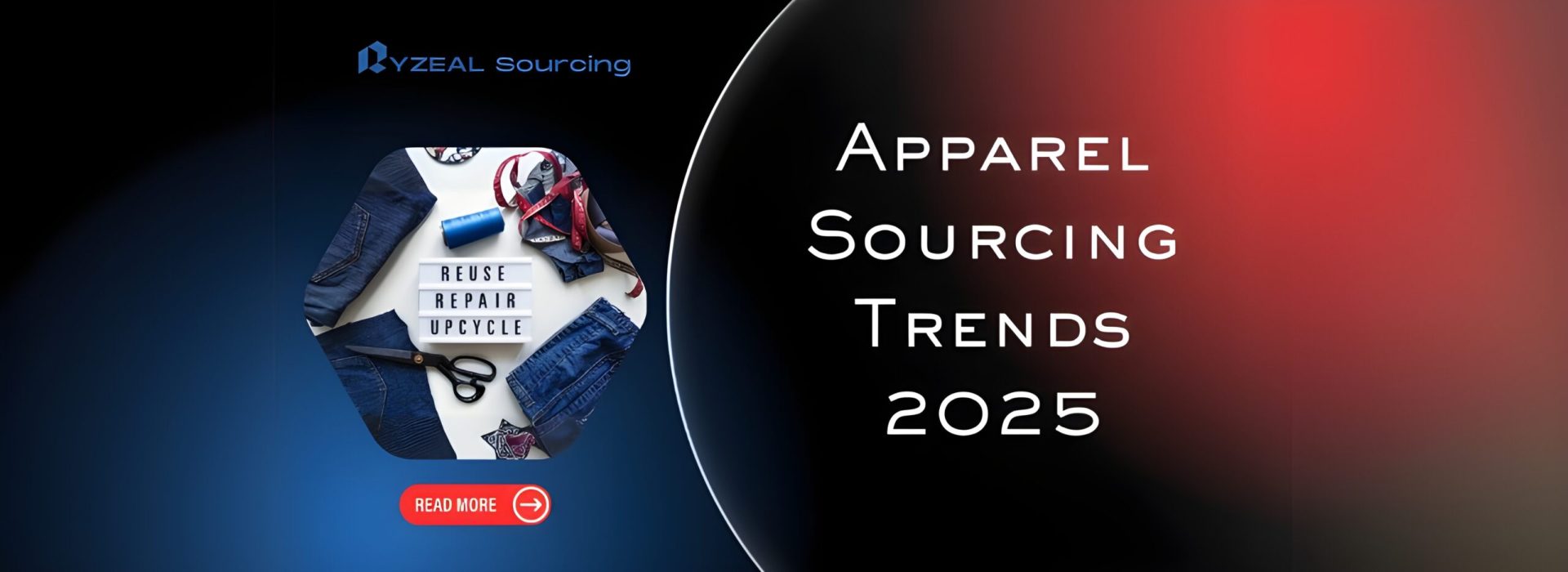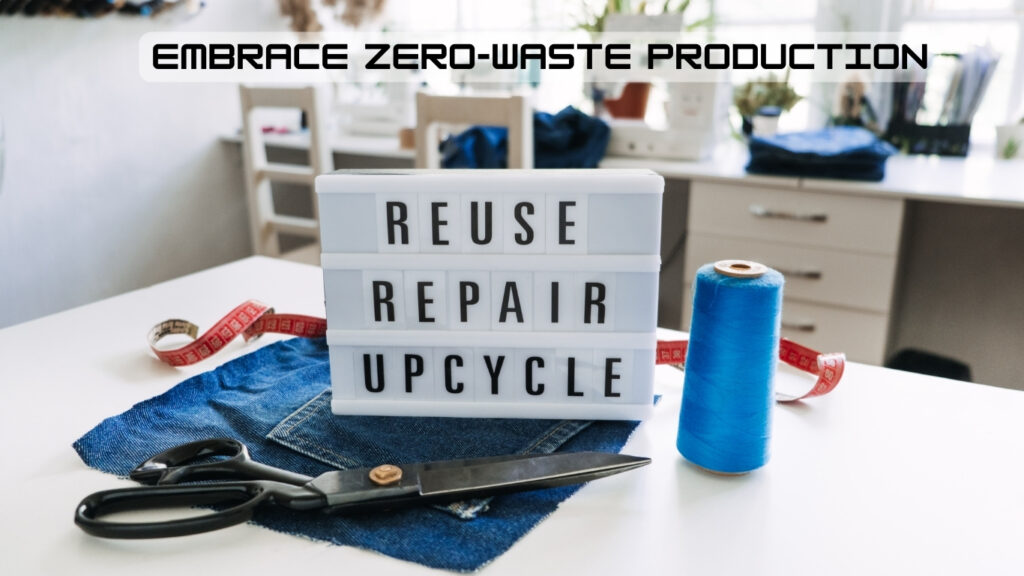
2025 Apparel Sourcing Trends: What Global Buyers Must Prepare For
The global apparel sourcing landscape is evolving rapidly, driven by trade policy changes, sustainability regulations, and digital innovations. Fashion buyers in 2025 must adopt new sourcing strategies, navigate supply chain disruptions, and meet increasing consumer expectations.
From nearshoring and automation to ethical production and AI-driven supply chains, apparel sourcing is undergoing a major transformation. This article explores the key sourcing trends shaping 2025 and provides actionable insights for buyers looking to stay ahead in the market.
Table of Contents
1. Nearshoring and Regionalized Supply Chains
With rising freight costs and geopolitical tensions, brands are moving away from traditional offshore manufacturing and adopting nearshoring strategies. This shift enables companies to reduce lead times, lower carbon footprints, and mitigate supply chain risks.
Why Nearshoring is Growing
- Global shipping delays and rising transportation costs are making offshore production less viable.
- Tariff regulations are encouraging brands to source closer to home¹.
- Consumers demand faster deliveries, leading brands to establish regional manufacturing hubs.
Key Nearshoring Strategies for 2025
- Expanding production in Latin America and Eastern Europe, reducing reliance on Asian suppliers.
- Automating regional factories to increase efficiency and compete with low-cost offshore production.
- Strengthening local textile supply chains, ensuring availability of raw materials within proximity.
Brands like Zara, H&M, and Uniqlo are already integrating regionalized sourcing models, shifting away from China and Southeast Asia.
2. Sustainable and Ethical Sourcing as a Compliance Requirement
Sustainability is no longer a marketing strategy—it is a compliance necessity. Governments are implementing stricter environmental laws, forcing brands to prioritize eco-friendly and ethical sourcing.
Why Sustainability is a Must in 2025
- The EU’s Green Deal and extended producer responsibility (EPR) policies will require brands to track and minimize textile waste ².
- Growing consumer demand for sustainable apparel is pushing brands to adopt low-impact fabric production³.
- Brands are transitioning to circular supply chains, promoting recyclable and biodegradable textiles.
Key Sustainable Sourcing Trends
- Bio-based and recycled textiles, minimizing environmental impact.
- Third-party sustainability certifications, ensuring fair labor and environmental compliance.
- Carbon-neutral factories, helping brands achieve global net-zero targets.
Companies like Patagonia, Levi’s, and Stella McCartney are leading sustainable sourcing efforts, setting new industry standards.
3. AI-Driven Digital Sourcing Platforms
Artificial intelligence (AI) is transforming apparel sourcing, enhancing supplier discovery, production tracking, and demand forecasting. Digital sourcing tools are making supply chains smarter, more transparent, and cost-effective.
Why AI-Powered Sourcing is the Future
Predictive analytics help buyers optimize supplier selection and order forecasting.
Automated quality control and compliance tracking improve procurement efficiency.
Blockchain transparency ensures traceability of raw materials and labor conditions ⁴.
Key Digital Sourcing Trends for 2025
AI-powered supplier matchmaking, reducing manual sourcing time.
Real-time production monitoring, improving visibility into supply chain operations.
Cloud-based inventory and logistics optimization, preventing overproduction.
Platforms like TradeBeyond, Sourcify, and Foursource are revolutionizing digital sourcing for fashion brands. Discover how Tech Mahindra’s cloud-based ReLoAD solution revolutionizes real-time serialized inventory management and logistics—watch the video to see it in action –
4. Geopolitical Factors Shaping Sourcing Strategies
Trade policies, economic sanctions, and regional instability are influencing sourcing decisions and forcing brands to diversify manufacturing locations.
How Geopolitics is Reshaping Apparel Sourcing
U.S. tariffs on Chinese imports are pushing brands to explore alternative sourcing destinations.
Bans on forced labor products, particularly cotton from Xinjiang, are affecting global supply chains ⁵.
Political instability in key apparel hubs, such as Myanmar and Bangladesh, is increasing sourcing risks.
Key Sourcing Adjustments for Buyers
Diversifying production across multiple regions, minimizing over-reliance on a single country.
Investing in politically stable sourcing markets, such as Vietnam, Turkey, and Mexico.
Strengthening supplier risk assessment frameworks, ensuring compliance with global trade laws.
Companies like Nike, Adidas, and VF Corporation are reevaluating supply chain stability, shifting toward multi-region sourcing models.
5. The Expansion of Near-Zero Waste Manufacturing
Fashion brands are investing in near-zero waste production models, focusing on 3D-knitting, on-demand manufacturing, and upcycling techniques.

Why Near-Zero Waste is the Future
Raw material costs are increasing, forcing brands to optimize fabric utilization.
Sustainable production models are appealing to environmentally conscious consumers.
Advancements in textile recycling are making waste-free manufacturing more feasible ⁶.
Key Waste-Reduction Strategies
3D-knitting and seamless garment production, eliminating fabric waste.
Made-to-order apparel, reducing excess inventory.
Closed-loop recycling programs, converting discarded textiles into new garments.
Brands like Unspun, Pangaia, and The North Face are pioneering zero-waste production models, driving a major shift in sustainable apparel sourcing.
6. The Acceleration of On-Demand and Agile Manufacturing
The traditional bulk production model is being replaced by on-demand and agile manufacturing, allowing brands to reduce inventory waste and adapt to fast-changing consumer trends.
Why On-Demand Manufacturing is Growing
Consumer preference for personalized fashion is driving the need for small-batch, custom production.
Brands want to minimize unsold inventory, reducing markdowns and waste.
Advanced automation and AI allow for quicker turnaround times in production.
Key Developments in On-Demand Manufacturing
Micro-factories utilizing AI-driven automation and robotics⁷.
Direct-to-consumer (DTC) production models, eliminating reliance on wholesale stockpiling.
Localized printing and 3D-knitting, enabling instant garment creation with near-zero waste.
With companies like Nike, Unspun, and Printful investing in on-demand production, this sourcing model is expected to reshape apparel manufacturing in 2025.
7. Strengthening Supplier Collaboration and Transparency
Brands are prioritizing long-term supplier partnerships, focusing on ethical labor practices, transparency, and co-innovation.

Why Strong Supplier Relationships Matter in 2025
Rising regulatory pressure requires brands to ensure fair wages and ethical working conditions.
Unstable supply chains demand greater collaboration between brands and factories.
Consumers expect transparency, making traceable sourcing a priority.
Key Trends in Supplier Collaboration
Blockchain technology providing real-time supply chain traceability⁸.
Joint sustainability initiatives, allowing brands and suppliers to share carbon reduction goals.
AI-powered supplier audits, improving compliance and ethical labor monitoring.
Brands like Levi’s, H&M, and Everlane are leading efforts to build fully transparent, traceable, and fair supply chains.
8. The Rise of Alternative Sourcing Hubs Beyond Asia
With rising labor costs and trade uncertainty in China and Southeast Asia, brands are exploring new sourcing destinations across Africa, Latin America, and Eastern Europe.
Why Alternative Sourcing Hubs Are Expanding
Manufacturing costs in Asia are increasing, making alternatives more attractive.
Trade policies and tariffs are pushing brands to diversify sourcing locations⁹.
Government incentives in emerging markets are attracting international apparel production.
Key Emerging Sourcing Hubs in 2025
Africa: Ethiopia and Egypt are becoming key players in low-cost textile manufacturing.
Latin America: Mexico and Brazil are rising as nearshoring destinations for U.S. brands.
Eastern Europe: Turkey and Poland offer proximity-based manufacturing for European retailers.
Global brands like PVH Corp, Inditex, and Adidas are increasingly shifting production outside Asia, securing more stable and cost-effective sourcing networks.
9. Apparel Trade Policies and Their Impact on Sourcing
New trade agreements and tariff regulations are reshaping apparel sourcing strategies, requiring brands to stay informed on policy shifts.
Why Trade Policy Awareness is Critical for Buyers
U.S.-China trade tensions continue to impact import tariffs on apparel.
European sustainability laws are setting stricter import regulations on textile waste and carbon emissions.
Developing countries are negotiating trade deals, increasing opportunities for new sourcing partners.
Key Apparel Trade Policy Changes in 2025
The U.S. Uyghur Forced Labor Prevention Act (UFLPA) bans imports linked to forced labor concerns in Xinjiang¹⁰.
The EU Corporate Sustainability Due Diligence Directive (CSDDD) requires brands to audit their supply chains for environmental and human rights compliance.
New trade agreements between Africa and Europe, improving duty-free sourcing opportunities.
Brands like Ralph Lauren, Patagonia, and Gap are working to navigate regulatory changes, ensuring compliance while maintaining cost efficiency.
10. The Growing Demand for Resilient and Flexible Supply Chains
Disruptions from climate change, pandemics, and geopolitical conflicts have made supply chain resilience a top priority for apparel buyers.
Why Supply Chain Resilience is Essential
Extreme weather events are impacting cotton and textile production.
Labor shortages are causing bottlenecks in apparel manufacturing.
Unforeseen global crises require sourcing teams to adapt quickly.
Key Strategies for Building Resilient Supply Chains
Diversification of suppliers, ensuring multi-region sourcing backup plans.
Flexible order volumes, allowing brands to scale production up or down as needed.
AI-powered risk analysis, helping brands **anticipate potential supply chain disruptions¹¹](https://www.mckinsey.com/industries/retail/our-insights/the-future-of-apparel-supply-chains).

Companies like Nike, Lululemon, and Puma are investing in supply chain resilience, ensuring long-term sourcing stability in an unpredictable global market.
RYZEAL’s Final Thoughts
Apparel sourcing in 2025 is shifting toward sustainability, flexibility, and digital transformation. Buyers must prepare for regionalized manufacturing, geopolitical challenges, and on-demand production models to remain competitive.
At RYZEAL SOURCING, we help brands navigate evolving sourcing landscapes, offering expertise in sustainable partnerships, AI-driven supply chain optimization, and strategic supplier diversification.
Fashion sourcing is no longer just about cost—it’s about building adaptive, transparent, and ethical supply chains that meet the future demands of the global market.
References
Business of Fashion – Why Apparel Brands Are Investing in Nearshoring – https://www.businessoffashion.com/articles/global-markets/apparel-brands-investing-in-nearshoring/
European Commission – EU Circular Economy and Extended Producer Responsibility (EPR) Policies – https://ec.europa.eu/environment/topics/circular-economy/textiles_en
Sourcing Journal – Bio-Fabric Innovation in Apparel Sourcing – https://www.sourcingjournal.com/topics/sustainability/bio-fabric-innovation-in-apparel-340234/
Forbes Tech Council – How AI is Transforming Global Supply Chains – https://www.forbes.com/sites/forbestechcouncil/2023/08/07/how-ai-is-transforming-global-supply-chains/
Reuters – U.S. Expands Import Ban on Cotton from Xinjiang Due to Forced Labor Concerns – https://www.reuters.com/business/retail-consumer/us-bans-cotton-imports-china-2024-01-15/
Wired – The Future of 3D-Knitting and Near-Zero Waste Fashion – https://www.wired.com/story/3d-knitting-future-of-fashion/
Business of Fashion – The Rise of On-Demand Manufacturing in Fashion – https://www.businessoffashion.com/articles/supply-chain/the-rise-of-on-demand-manufacturing-in-fashion/
Forbes – Blockchain’s Role in Fashion Supply Chain Transparency – https://www.forbes.com/sites/forbestechcouncil/2023/03/21/blockchain-in-fashion-supply-chains/
Reuters – Why Brands Are Looking Beyond Asia for Apparel Sourcing – https://www.reuters.com/business/retail-consumer/why-brands-are-looking-beyond-asia-for-apparel-sourcing-2024-02-15/
Reuters – U.S. Expands Import Ban on Goods Linked to Forced Labor in Xinjiang – https://www.reuters.com/world/us/us-expands-import-ban-china-xinjiang-2023-12-20/
McKinsey & Company – The Future of Apparel Supply Chains: Risk Management & Resilience – https://www.mckinsey.com/industries/retail/our-insights/the-future-of-apparel-supply-chains

Costing in Garment Industry – How Buyers and Factories Calculate Pricing Effectively

